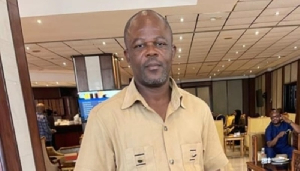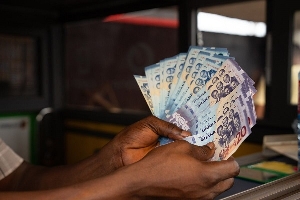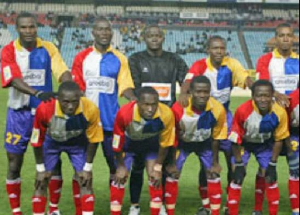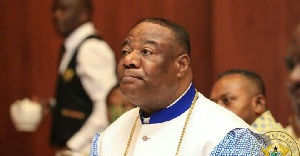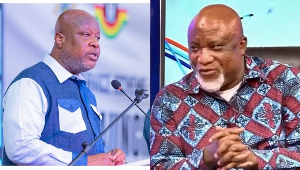 The dwetɛ kuduo is present wherever the Asantehene goes
The dwetɛ kuduo is present wherever the Asantehene goes
An ardent observer of the Asantehene, Otumfuo Osei Tutu II, would perhaps notice one consistent feature in the public appearance of the overlord of the Ashanti Kingdom.
The king's outfit might be different on different occasions, he might be riding in a palanquin or walking, but there is always this one man carrying a strange oval-shaped object either in front of or beside the Asantehene.
Manhyia-affiliated social media handle, Asanteman Kingdom has given details of what the object is and what it stands for.
The mystical oval-shaped object is called the ‘dwetɛ kuduo’, which translates as Silver Casket, and the man who carries it is called the Dwetɛkuduohene, Nana Osei Kuffour.
Although technically, the ‘dwetɛ kuduo’ is not a stool, it always precedes the stool carriers when the Asantehene is carried in the palanquin, and when the Asantehene is not present, it is placed in front of the King's stool.
Understanding the relevance of the ‘dwetɛ kuduo’ and why the Golden Stool cannot move without it dates back to the beginning of the Ashanti Kingdom.
According to Asanteman Kingdom, a Facebook page known for publishing and writing about the Ashanti Kingdom, after unifying all the divisions of Asante with the Golden Stool, Komfo Anokye informed Asantehene Nana Osei Tutu I that he needed the ‘Dwetɛ kuduo’, then belonging to the Bodweseanwohene, Nana Adu Gyamfi, to facilitate and ensure victory for Asante in all potential and subsequent wars.
To emphasise the relevance of the ‘dwetɛ kuduo’ to the Golden Stool, Komfo Anokye mentioned that the Dwetɛkuduo possessed special powers that are needed to strengthen and reinforce that of the Golden Stool.
The revered fetish priest added that the ‘dwetɛ Kuduo’, when secured, would provide Asanteman ahoɔden (strength), akwankyerɛ (guidance), nimdeɛ (knowledge), and akokoɔduro (bravery) to successfully defend the state against all enemies.
According to Komfo Anokye, Asanteman would win all battles and wars should the ‘dwetɛ kuduo’ be secured in addition to the Golden Stool. It is worth knowing that, prior to this directive from Komfo Anokye, Asante had lost seven different wars against the Bodweseanwohene, Nana Adu Gyamfi. This meant that securing the ‘dwetɛ kuduo’ was not going to be an easy task.
Asantehene Opemsuo Osei Tutu I consulted Komfo Anokye for guidance, and they decided to deploy Deɛboɔsohene to Bodweseanwohene as an undercover agent to help the Ashantis secure the ‘dwetɛ kuduo’. After more than three years of intelligence gathering, a marriage to the niece of Nana Adu Gyamfi, and becoming friends with him, Asanteman (the Ashanti kingdom) was able to defeat Bodweseanwo and secure the ‘dwetɛ kuduo’.
Once in Kumasi, Nana Osei Tutu I appointed a carrier and created a stool for him, and as a result, there is the Dwetɛkuduohene. As a very relevant chief in Asante, the Dwetɛkuduohene swears his oath of office to the Asantehene and has access to the royal chamber.
The ‘dwetɛ kuduo’ is the last regalia item that is handed to a newly installed Asantehene to formally complete the enstoolment, and in times of serious state business such as complex land cases or succession cases, the Asantehene places his right hand on the ‘dwetɛ kuduo’ to enable him to strengthen and empower him to negotiate difficult cases.
Below is the history of the ‘dwetɛ kuduo’ as provided by Asanteman Kingdom
After unifying Asante with the Gold Stool and adding a variety of regalia items, Komfo Anokye informed Opemsoɔ Osei Tutu that they needed the dwetɛ kuduo belonging to Bodweseanwohene Nana Adu Gyamfi to ensure victory in potential wars.
According to Komfo Anokye, Nana Adu Gyamfi’s dwetɛ kuduo possesses special tumi (powers) that are needed to reinforce that of the Gold Stool.
The analogy, according to Baafoɔ Osei Asibe, is like buying a car with no gas in it or a car without tyres. In that sense, it is fair to say that the dwetɛ kuduo provides Asanteman with ahoɔden (strength), akwankyerɛ (guidance), nimdeɛ (knowledge), and akokoɔduro (bravery) to successfully defend the kingdom against aggression from potential enemies.
Further, Komfo Anokye informed them that victories in wars are assured once they are able to add the dwetɛ kuduo to the Gold Stool.
Obtaining Nana Adu Gyamfi’s dwetɛ kuduo was not easy as Opemsuo fought Nana Adu Gyamfi on seven different occasions, but the latter’s forces defeated the Asante forces in all the encounters. After failing to defeat Nana Adu Gyamfi, the king, in consultation with Komfo Anokye, came up with a new strategy that would not require the use of force. For the new scheme, the Deɛboɔsohene was sent to Bodweseanwo as an undercover agent to capture the dwetɛ kuduo and bring it to Kumase.
After a couple of months, he returned and reported to his superiors that it was an impossible mission. Faced with a near-impossible situation, Komfo Anokye then performed special rituals for Deɛboɔsohene to enable him to withstand any spiritual forces that might prevent him from accomplishing his mission.
Following the rituals, Deɛboɔsehene went back to Bodweseanwo as a palm wine tapper and lived there for three years. In that time, he occasionally returned to Kumase to report and update his superiors on his investigations.
In the process, Deɛboɔsohene managed to marry Nana Adu Gyamfi’s niece, and that gave him the opportunity to get closer to the chief’s court.
Due to his knowledge of the Asante court traditions, he endeared himself to the courtiers and soon developed a close relationship with Nana Adu Gyamfi.
Eventually, he was able to coordinate with the Asante forces and arrange a day to move in and seize the dwetɛ kuduo. On this day, Deɛboɔsohene killed Nana Adu Gyamfi and fled with the dwetɛ kuduo.
With perfect coordination, the Asante forces provided him with cover, surrounded Bodweseanwo, and with a surprise attack, defeated them for the first time and finally brought the dwetɛ kuduo safely back to Kumase.
Once in Kumase, Osei Tutu identified a carrier and created a stool for him, and as a result, we have the Dwetɛkuduohene, but Deɛboɔsohene is recognized as the one who brought it to Kumase. The Dwetɛkuduohene swears his oath of office to Otumfoɔ in addition to having access to the royal chamber.
Kuduo refers to a special container where precious items are kept, while dwetɛ is the Twi word for silver.
Dwetɛ kuduo, therefore, means a kuduo made of silver (Raymond Silverman, 1983: 10-29, examines in detail the form and function of the kuduo in Akan).
In the past, the Akan used kukuo (earthenware pot) or kɛntɛnku (woven basket made from cane or the back of palm branches) for similar purposes, and expensive cloths, jewellery, and other valuable items were placed in it for safekeeping.
As mentioned previously, the Asantehene’s dwetɛ kuduo contains several ritual objects that collectively give him tumi (power), and it is always in his presence.
The Dwetɛ kuduo is the last regalia item that is handed to a newly installed Asantehene to formally complete the ceremonies of his installation. During processions, the carrier walks to the right of the Asantehene and within easy access of the king.
It is placed on the king’s right when he sits in state. In times of crises, or when judging extremely complex land or succession cases, the king places his right hand on the dwetɛ kuduo, and it is said to be able to transmit the ahoɔden (strength) and tumi that he may need to negotiate difficult cases.
By virtue of his office, the Dwetɛkuduohene is able to transmit tumi if the king places his right hand on his heart.
BAI/ADG
Watch the latest episode of Everyday People below:
Ghana’s leading digital news platform, GhanaWeb, in conjunction with the Korle-Bu Teaching Hospital, is embarking on an aggressive campaign which is geared towards ensuring that parliament passes comprehensive legislation to guide organ harvesting, organ donation, and organ transplantation in the country.
- Once you’re interested in education, you are his friend - Otumfuo’s daughter reveals
- ‘It’s sheer envy’ – Akrobeto berates Dormaahene for accusations against Otumfuo in Sampa dispute
- Otumfuo @25: Why Denkyirahene weeps before paying homage to Asantehene
- All smiles as Asiedu Nketiah greets Akufo-Addo at Otumfuo @ 25 celebration
- Why only Otumfuo is permitted to wear 3 golden triangular necklaces at a durbar
- Read all related articles


